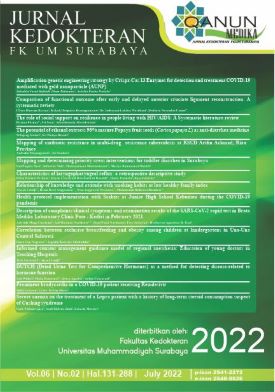DUTCH (Dried Urine Test for Comprehensive Hormones) In Preventing Diseases Related Hormonal Function
Abstrak
Hormones released and absorbed by the human body in a balanced state will help create balance and health, while changes in hormone levels can cause various severe and chronic health problems. Hormone test is a method of measuring hormone levels in the body that can be used to diagnose and treat diseases, monitor patient health as a whole, or prevent the growth of certain health problems. This research might be the information about. the functional hormone test (DUTCH). This study presented a case of a 47 years old woman with history of chronic dysmenorrhea. The functional hormone testing was carried out on days 19-22 of the menstrual cycle in women with a regular period of 28 days. The result of DUTCH test in this patient were dominant 2-OH that she safe from the symptoms of estrogen dominance and low production of 4-OH, the methylation process was fluent so that the risk of cancer-related to estrogen dominance syndrome was low. Hormone examination through urine is intended to see metabolites (metabolic waste) hormones released through urine. By witnessing the estrogen & progesterone metabolites, it can be seen how much risk a person has Estrogen Dominance Syndrome.
Artikel teks lengkap
Referensi
Bédard, Nancy J. Martin, Paul Krueger, Kevin Brazil, M., 2000. Assessing reproducibility of data obtained with instruments based on continuous measurements. Experimental Aging Research, 26(4), pp.353-365.
Black, C.N., Bot, M., Scheffer, P.G., Cuijpers, P. and Penninx, B.W., 2015. Is depression associated with increased oxidative stress? A systematic review and meta-analysis. Psychoneuroendocrinology, 51, pp.164-175.
Blasco, H., Garrigue, M.A., De Vos, A., Antar, C., Labarthe, F., Maillot, F., Andres, C.R. and Nadal-Desbarats, L., 2010. Filter paper saturated by urine sample in metabolic disorders detection by proton magnetic resonance spectroscopy. Analytical and bioanalytical chemistry, 396(3), pp.1205-1211.
Direito, A., Bailly, S., Mariani, A. and Ecochard, R., 2013. Relationships between the luteinizing hormone surge and other characteristics of the menstrual cycle in normally ovulating women. Fertility and sterility, 99(1), pp.279-285.
Groenewoud, E.R., Macklon, N.S., Cohlen, B.J., Al-Oraiby, A., Brinkhuis, E.A., Broekmans, F.J., de Bruin, J.P., van der Dool, G., Fleisher, K., Friederich, J. and Goddijn, M., 2017. The effect of elevated progesterone levels before HCG triggering in modified natural cycle frozen-thawed embryo transfer cycles. Reproductive biomedicine online, 34(5), pp.546-554.
de Jong, W.H., Buitenwerf, E., Pranger, A.T., Riphagen, I.J., Wolffenbuttel, B.H., Kerstens, M.N. and Kema, I.P., 2018. Determination of reference intervals for urinary steroid profiling using a newly validated GC-MS/MS method. Clinical Chemistry and Laboratory Medicine (CCLM), 56(1), pp.103-112.
Klein, D.A., Paradise, S.L. and Reeder, R.M., 2019. Amenorrhea: a systematic approach to diagnosis and management. American family physician, 100(1), pp.39-48.
Krone, N., Hughes, B.A., Lavery, G.G., Stewart, P.M., Arlt, W. and Shackleton, C.H., 2010. Gas chromatography/mass spectrometry (GC/MS) remains a pre-eminent discovery tool in clinical steroid investigations even in the era of fast liquid chromatography tandem mass spectrometry (LC/MS/MS). The Journal of steroid biochemistry and molecular biology, 121(3-5), pp.496-504.
Marcos, J., Renau, N., Casals, G., Segura, J., Ventura, R. and Pozo, O.J., 2014. Investigation of endogenous corticosteroids profiles in human urine based on liquid chromatography tandem mass spectrometry. Analytica chimica acta, 812, pp.92-104.
McCann, M.T., Thompson, M.M., Gueron, I.C., Lemieux, B., Giguere, R. and Tuchman, M., 1996. Methylmalonic acid quantification by stable isotope dilution gas chromatography-mass spectrometry from filter paper urine samples. Clinical chemistry, 42(6), pp.910-914.
Newman, M., Pratt, S.M., Curran, D.A. and Stanczyk, F.Z., 2019. Evaluating urinary estrogen and progesterone metabolites using dried filter paper samples and gas chromatography with tandem mass spectrometry (GC–MS/MS). BMC chemistry, 13(1), pp.1-12.
Newman, M. and Curran, D.A., 2021. Reliability of a dried urine test for comprehensive assessment of urine hormones and metabolites. BMC chemistry, 15(1), pp.1-13.
Rezvanpour, A. and Don-Wauchope, A.C., 2017. Clinical implications of estrone sulfate measurement in laboratory medicine. Critical reviews in clinical laboratory sciences, 54(2), pp.73-86.
Roos, J., Johnson, S., Weddell, S., Godehardt, E., Schiffner, J., Freundl, G. and Gnoth, C., 2015. Monitoring the menstrual cycle: Comparison of urinary and serum reproductive hormones referenced to true ovulation. The European Journal of Contraception & Reproductive Health Care, 20(6), pp.438-450.
Sampson, J.N., Falk, R.T., Schairer, C., Moore, S.C., Fuhrman, B.J., Dallal, C.M., Bauer, D.C., Dorgan, J.F., Shu, X.O., Zheng, W. and Brinton, L.A., 2017. Association of estrogen metabolism with breast cancer risk in different cohorts of postmenopausal women. Cancer research, 77(4), pp.918-925.
Sansone, A., Sansone, M., Selleri, R., Schiavo, A., Gianfrilli, D., Pozza, C., Zitzmann, M., Lenzi, A. and Romanelli, F., 2019. Monitoring testosterone replacement therapy with transdermal gel: when and how?. Journal of endocrinological investigation, 42(12), pp.1491-1496.
Savkovic, S., Lim, S., Jayadev, V., Conway, A., Turner, L., Curtis, D., Goebel, C. and Handelsman, D.J., 2018. Urine and serum sex steroid profile in testosterone-treated transgender and hypogonadal and healthy control men. The Journal of Clinical Endocrinology & Metabolism, 103(6), pp.2277-2283.
Schiffer, L., Barnard, L., Baranowski, E.S., Gilligan, L.C., Taylor, A.E., Arlt, W., Shackleton, C.H. and Storbeck, K.H., 2019. Human steroid biosynthesis, metabolism and excretion are differentially reflected by serum and urine steroid metabolomes: A comprehensive review. The Journal of steroid biochemistry and molecular biology, 194, p.105439.
Shackleton, C., 2010. Clinical steroid mass spectrometry: a 45-year history culminating in HPLC–MS/MS becoming an essential tool for patient diagnosis. The Journal of steroid biochemistry and molecular biology, 121(3-5), pp.481-490.
Stanczyk, F.Z. and Clarke, N.J., 2010. Advantages and challenges of mass spectrometry assays for steroid hormones. The Journal of steroid biochemistry and molecular biology, 121(3-5), pp.491-495.
Penulis

Qanun Medika oleh FK UM Surabaya disebarluaskan di bawah Lisensi Creative Commons Atribusi 4.0 Internasional.
Berdasarkan ciptaan pada http://journal.um-surabaya.ac.id/index.php/qanunmedika.

